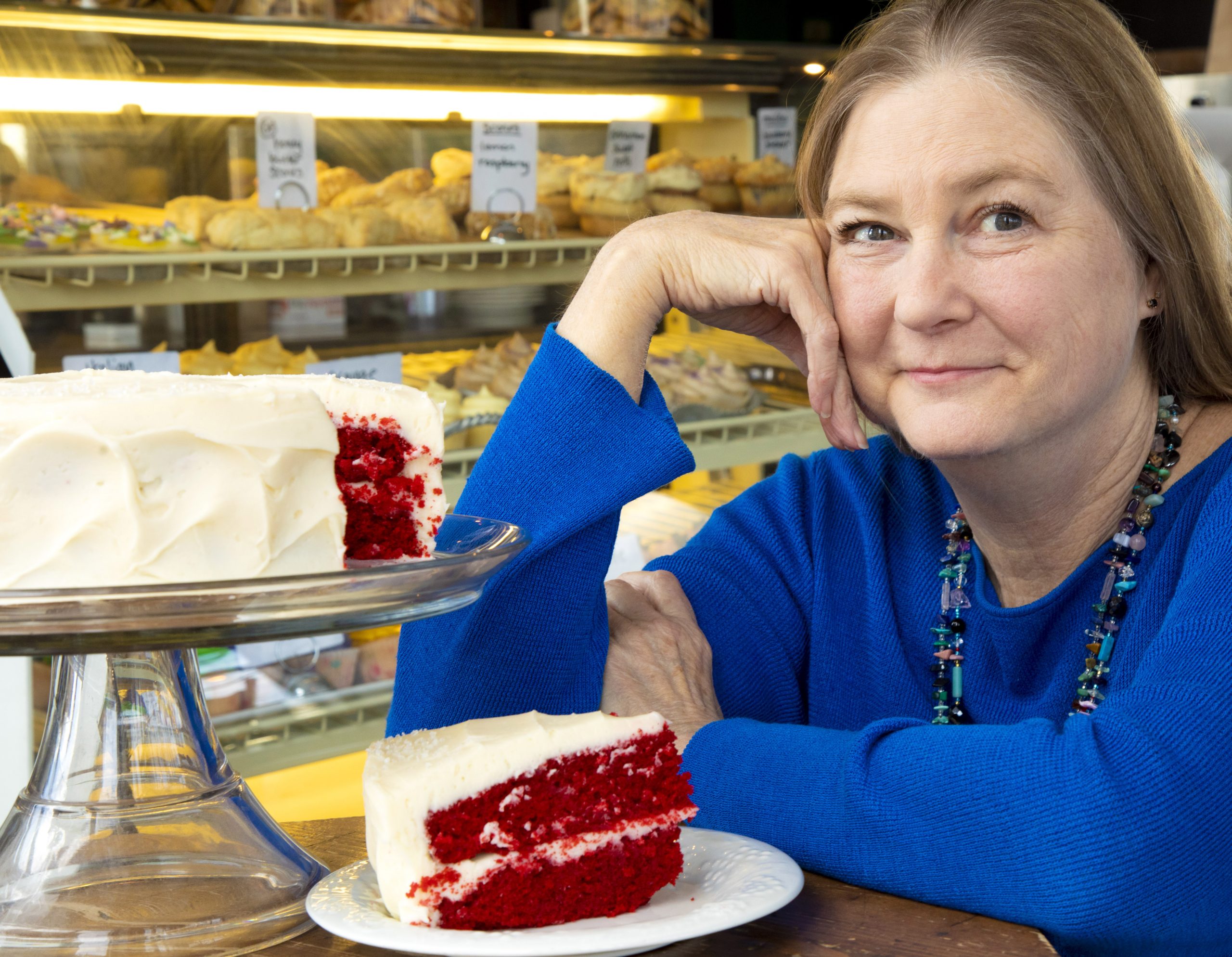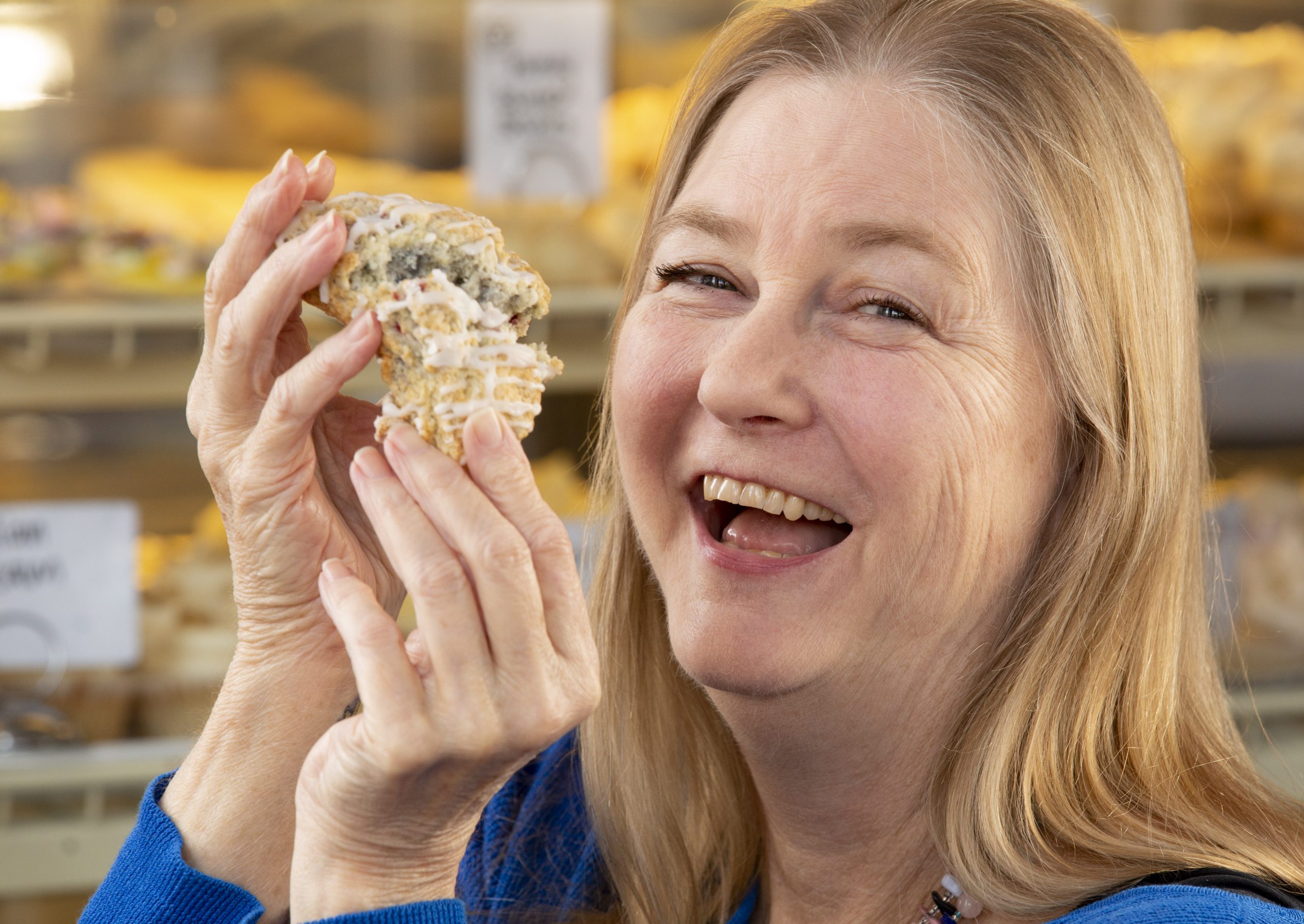Telling the South’s Story Through Baking
The book Grain and Fire examines how multicultural traditions enrich Southern cuisine.

TCU history professor Rebecca Sharpless explores the ties between baking and culture in the South in her book Grain and Fire: A History of Baking in the American South. Photo by Joyce Marshall
Telling the South’s Story Through Baking
The book Grain and Fire examines how multicultural traditions enrich Southern cuisine.
A pink cake for her second birthday inspired Rebecca Sharpless’ lifelong love affair with buttercream frosting and confections. Decades later, the professor of history at TCU and self-described Southern baker cooked her way through the Covid-19 pandemic, turning out treats like aniseed shortbread and orange scones.
Her 2022 book, Grain and Fire: A History of Baking in the American South, shows that Southern baking not only tastes and smells good, but it reflects the rich, multiethnic history of the region.
Sharpless writes that the merging of early Americans — including Native Americans, European settlers and enslaved people from Africa — influenced the first Southern foodways as people learned from one another and adapted recipes and traditions.
“Baking is one way of trying to explain how the South came to be like it is.”
Rebecca Sharpless, TCU history professor
She traces the roots of Southern baking to the acorn and chestnut bread made 10,000 years ago by Native Americans, who fed the concoction to European settlers when the staples they were accustomed to, such as wheat flour, were not available.
Baking also reinforced the privilege of the wealthy and made social distinctions across class and race. Sharpless doesn’t gloss over the fact that much of the baking and other kitchen work was done by indentured servants and enslaved people, mainly women, and often under difficult, even painful conditions.
“Baking is one way of trying to explain how the South came to be like it is,” Sharpless said.
In Grain and Fire, she deconstructs the layers of baking, revealing how immigrant traditions brought to America have influenced — and still influence — baked goods in Southern homes.
Corn vs. Wheat
Amid the early American hunter-gatherer culture, baking was simpler, with fewer ingredients, such as seeds, nuts and roots, and minimal cooking tools.
“Before Europeans came to America, baked goods were not sweet” because sugar wasn’t available, Sharpless said. Europeans brought sugar and wheat flour to America, but both were expensive and a rarity for poor and enslaved people.
Corn, however, was native, cheap and plentiful in the South.
Mainly wealthy, upper-class settlers ate bread made with wheat flour, while average colonists and enslaved people used corn as their daily grain. Johnnycakes and pone bread made of ground corn were common. Corn often was the “only source of food for enslaved people, who may have eaten cornbread three times a day,” Sharpless said.
Her research on corn is important, said Alan Gallay, TCU’s Lyndon B. Johnson Chair in American History. “Corn is the Southern crop; it’s the basis of life here.”

“Before Europeans came to America, baked goods were not sweet,” said TCU history professor and author Rebecca Sharpless. Photo by Joyce Marshall
The Voice of Baking
The book also reveals the powerful language of food.
During the Civil War, baked goods were used to show affection, loyalty and political support. Sharpless said the 1928 Woman’s Club of Fort Worth Cook Book contains two recipes for Jefferson Davis pie, a spiced custard pastry named in honor of the president of the Confederacy.
Baked goods even were used to engage in espionage. Adele Cutts Douglas, the widow of U.S. Sen. Stephen A. Douglas, baked a cake and hid between its layers cash to bribe guards and a plan to help her niece and Confederate spy Rose O’Neal Greenhow escape Union custody.
Music and literature also include references to baking. Harper Lee featured a boozy lane cake in To Kill a Mockingbird.
Sharpless has long been interested in how women, food and labor intersect in the American South. Her 2010 book, Cooking in Other Women’s Kitchens: Domestic Workers in the South, 1865-1960, won the Southern Historical Association’s Bennett H. Wall Award for the best book on Southern economic or business history.
Grain and Fire shows how female innovation influenced baking during wars and economic hardship. Women used ale yeast, the foam that forms atop fermenting liquid, to leaven bread through the 1700s and molasses or sorghum syrup instead of sugar through the mid-1800s.
True South
Does Southern baking really exist?
“She’s using every possible source — early American accounts, agricultural bulletins, cookbooks, newspapers, memoirs, slave narratives and oral histories.”
Jodi Campbell, TCU history professor
Yes, said Sharpless, who grew up in Waco, Texas.
“If you’re a Southerner or you live in the South or you’re baking a time-honored recipe from the South, then it’s Southern,” Sharpless writes. She found, however, that some iconic Southern desserts, such as chess pie, may not be Southern at all.
“One of the great mysteries of Southern baking is chess pie,” she writes. “No one knows exactly where or when it was invented or why it is called that.”
The book also debunks other myths about Southern baking. The origins of some storied Southern cakes, including Coca-Cola cake and red velvet cake, can’t be verified.
Sharpless began researching Grain and Fire in 2014, perusing some 140 cookbooks spanning 400 years, as well as many other forms of research listed in the book’s 47-page bibliography.
“She’s using every possible source — early American accounts, agricultural bulletins, cookbooks, newspapers, memoirs, slave narratives and oral histories,” said Jodi Campbell, a professor of history at TCU who translated Spanish explorer records from the early 1600s for Sharpless’ book.
As a result, Grain and Fire isn’t just a culinary history; it’s a social history of the American South as seen through the lens of baking. The book notes that the South’s changing demographics, with more people from places like China, India, Mexico, Nigeria and Vietnam, continue to influence baking today.
“Southern baking is constantly evolving,” Sharpless said. “The most recent thing I baked was a tres leches cake.”

Your comments are welcome
Comments
Related Reading:
Research + Discovery
The Can-Do Spirit
Neeley professor Keith Hmieleski uses his training in psychology and business to discover what makes entrepreneurs tick.
Research + Discovery
Digital Safety Net
John T. Harvey recommends creating a Federal Cyber Insurance Corp., which would protect the U.S. from ransomware and other online crimes.